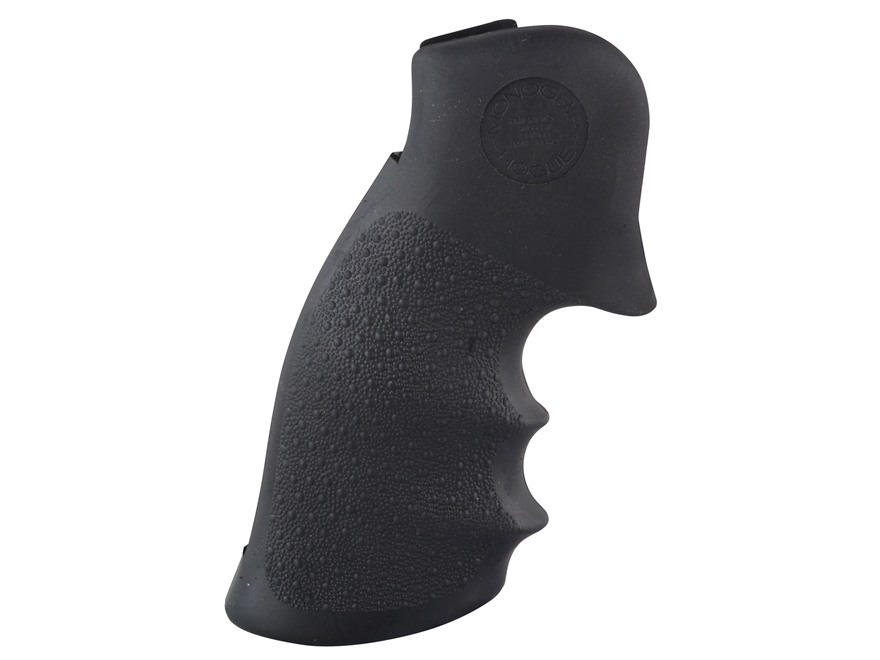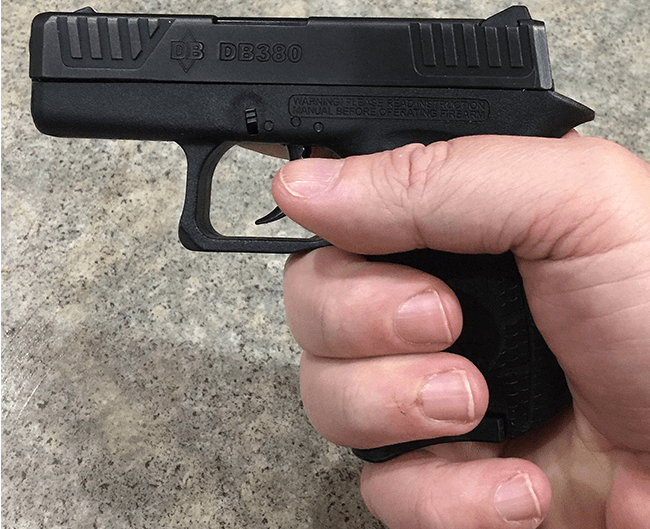Handgun Grip Tips
They say a handgun with the proper grip fits your hand like a well-made glove. You’ll just pick it up and know that it is right. That thought looks great on paper and is something we can all relate to, but it is fish bait. If you catch a lot of fish, the bait was great! If you do not catch a fish, it was the bait’s fault.
It is true that your handgun grip should feel good in your hand. If it is too rough or too large or too small it will not only feel wrong, it can be unsafe. But the feel of the grip can lie to you as well — especially when you have shot the gun for a while and become accustomed to it.
When I was first introduced to shooting at a young age, my stepfather brought two .38 pistols. One was a Colt, the other a Smith & Wesson. I was young and not a strong as I could have been, and so the Colt felt too heavy compared to the S&W. After the safety lecture and demo, I went straight for the Smith. When my dad asked me to try the Colt, I immediately shied away.
After a little encouragement, I gave the Colt a try. It was heavy and gave me a little trouble, but the paper didn’t lie. The heavier weight resulted in less recoil, less flinch and anticipation, and better groups.
A very similar thing happened to me years later while shooting one of my favorite pistols. I received a set of laser grips for testing, and I headed out to shoot a steel target match the following day with those new grips installed on my favorite match pistol. At first, I thought it was a happenstance; perhaps I was just having a good day on the range. But then my coach noted that my grip was the most consistent he had seen me use. Turns out that the laser grips were slightly larger than the ones I was accustomed to. They felt awkward but actually improved my grip.
In this video, Top Shot Champion Chris Cheng demonstrates for beginners how to properly grip a semi-auto pistol. Firearm instructors and experienced shooters are encouraged to watch and share these tips with newcomers to the shooting sports.
When it comes to finding the right handgun grips for you and your shooting performance, remember that a grip that feels like it is molded to your hand is great, but downrange performance is most important. Fortunately, many manufacturers, such as Hogue, feature several dozens of grip options, often with several for individual handgun models. Many manufacturers today also include a modular grip feature into their handguns, so that the user can modify the gun several different ways and discover which works best for them. Popular examples of these guns include Smith and Wesson’s M&P line and just about any of the 3rd and 4th generation Glocks.
When I got my last Glock, I started with just the pistol. During subsequent shooting sessions, I stepped up on the backstrap sizes, one per session. In addition to group size, I noted speed, hand purchase (the sureness of my grip on the gun) when it was hot and I was perspiring and consistency in shooting. Those notes helped me discover which configuration was right for me.
Grip Considerations When Buying a Handgun
A bit of an admission here. I used to tell new shooters buying their first handgun to handle as many as possible. “When you find the one that feels right, you’ll know the one you need to buy.” However, if experienced shooters can’t “feel” the one that will shoot best, how could I recommend beginners to do that to choose a handgun?
When choosing a handgun and, subsequently, any after-market grips, safety is first. Safety issues to consider:
- A gun truly is too heavy or in any way keeps you from obtaining and maintaining a clear sight picture
- A gun that does not permit you the ability to safely reach the controls (safety, magazine release, slide stop and cylinder release).
- A gun that prevents you from achieving and maintaining both a proper grip and proper control of the trigger.
Let’s take a closer look at each of these and some other common grip problems.
Unable to Reach Controls
At minimum, you have to be able to reach the magazine release and safety (if applicable) on a semi-auto without altering your firing grip (though of course with your finger off the trigger). If your hands are too small, look for a slimmer grip. Big hands can be an issue as well, especially when it comes to proper placement of the trigger finger on the trigger; a big hand on a too-small grip can have the shooter putting their finger too far through the trigger guard, with the first knuckle on the trigger instead of a the pad of the finger.
Grip is Too Wide
Ideally, your forearm will be in line with the handgun. However, if the grip is too wide, a right-handed shooter will shift the grip to the right (and the opposite for lefties). This causes the recoil to be absorbed by the thumb and can degrade accuracy.
Trigger
Not being able to adequately reach the trigger is often related to grip thickness. This is where a model with replaceable backstraps really shines. Starting without an adapter, check the feel and trigger reach. You can then add the smallest backstrap if you find your trigger finger too far through the trigger guard. Keep going up in size until you have a comfortable grip and proper placement of the trigger finger pad on the trigger.
Problems with trigger reach are particularly noticeable on double-action revolvers. Depending on the problem, you may be able to drop down in size with an aftermarket, slimmer grip.
Finger Grooves
Ask a shooter to name a brand of pistol grips and Hogue will likely be the first off their tongue. We all know hands are not the same size, so finger grooves, while they seem practical, are actually problematic for most. Yet Glock Gen 3 and Gen 4 Models feature them prominently, as do Hogue’s revolver monogrips. I can’t argue with the success of the gun or the grips, but if they do not work for you, look for another grip design with which you can consistently develop a proper grip. Remember, just because you can easily place your fingers in the grooves does not mean you’ll have a proper, repeatable grip.
Grip Length
Pocket pistols and mid-sized handguns are extremely popular among the concealed carry crowd. A handgun that is easier to conceal than another is often a selling point. However, once on the range, you may find it hard or unpleasant to shoot such small guns and their inherently short grips. Don’t worry too much. Several popular models today offer magazines that will extend the grip. This increases the capacity and gets that last pinkie finger on the gun too. Keep in mind that the short-grip problem is exacerbated in small revolvers with the square-bottomed “boot grips.”
Conclusion
When discussing handgun grips, you have options. Odds are, you will never need them. Typically, it is not very hard for most shooters to find a gun that fits their hand or to make a few minor adjustments to the grip that will provide good service. As was the case with my own shooting, switching grips, a little trial and error and a few fun days at the range though had me shooting better with that favorite gun than I’d ever shot it before. Best of all, most practical shooting grips are relatively inexpensive, so buying two or three sets in the search for your best grip won’t break the bank.

